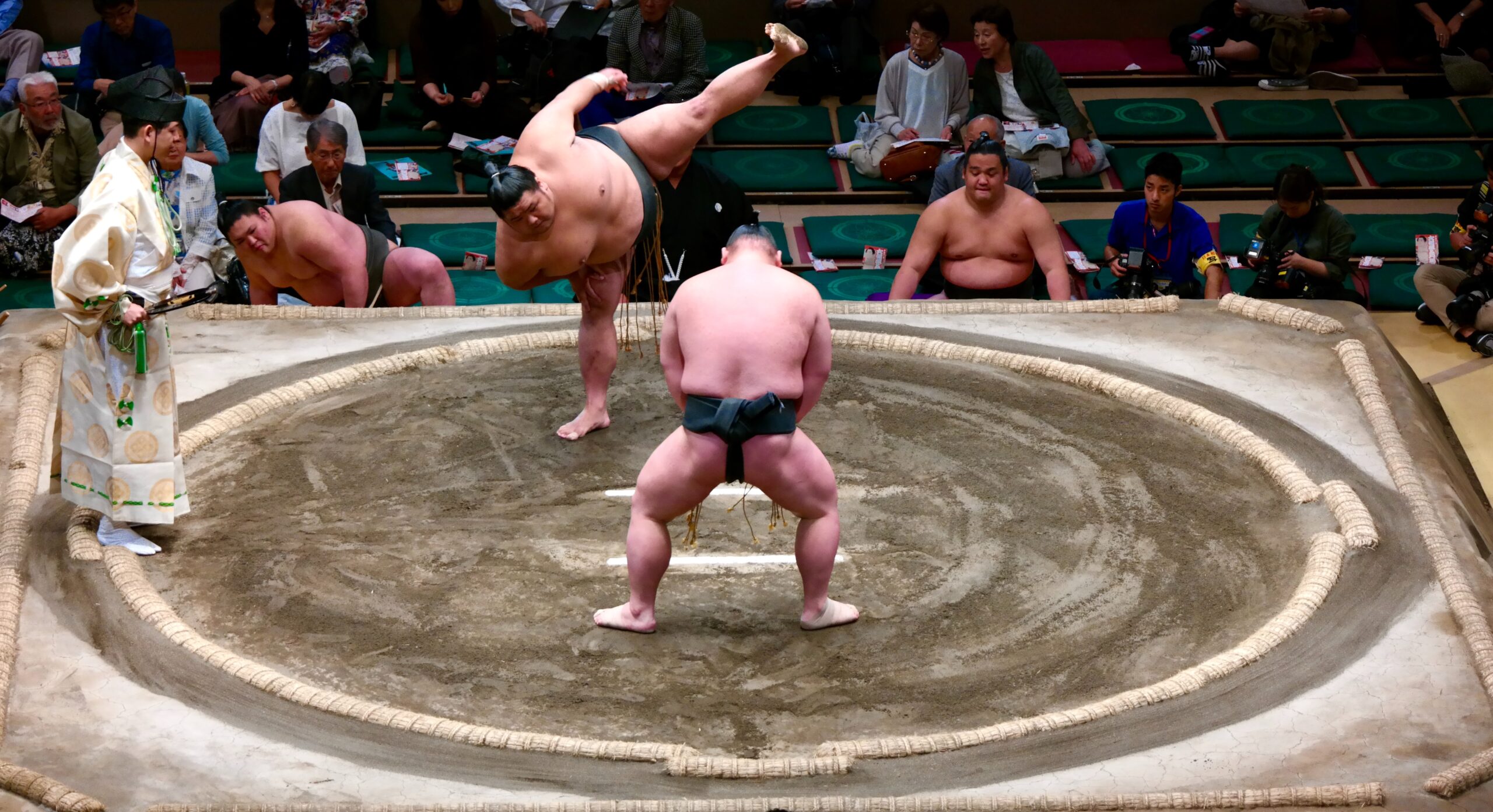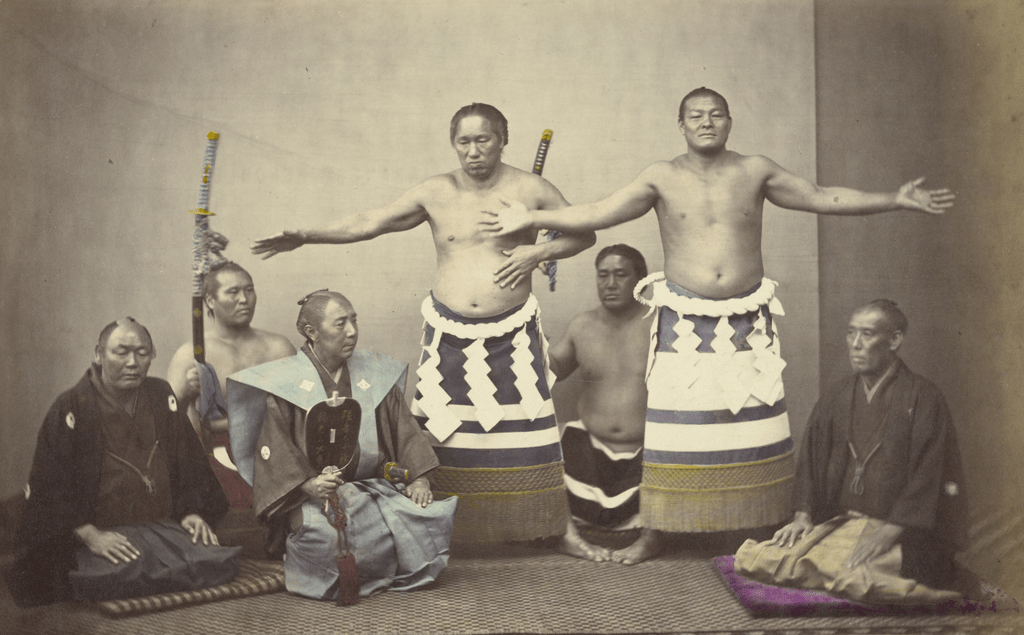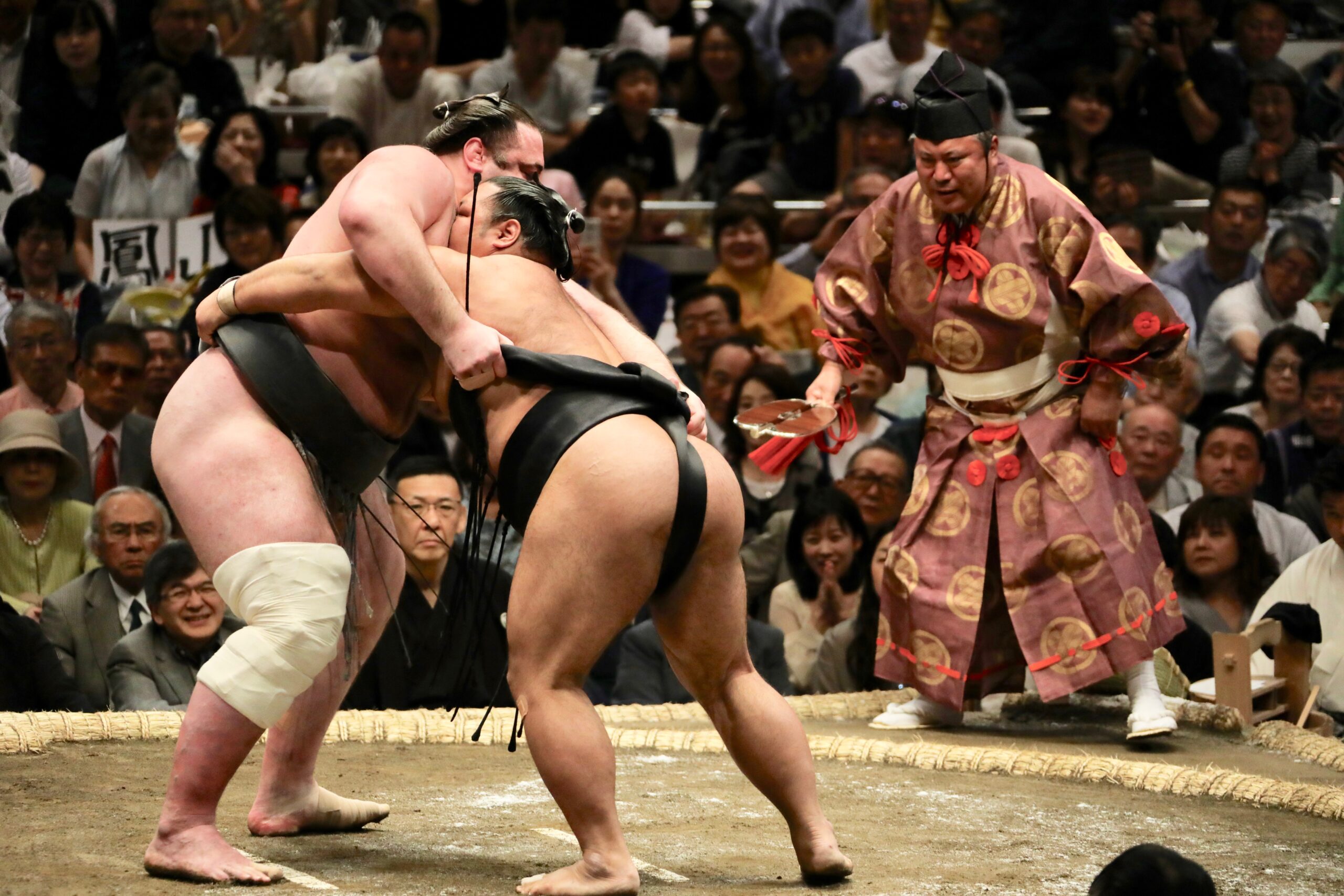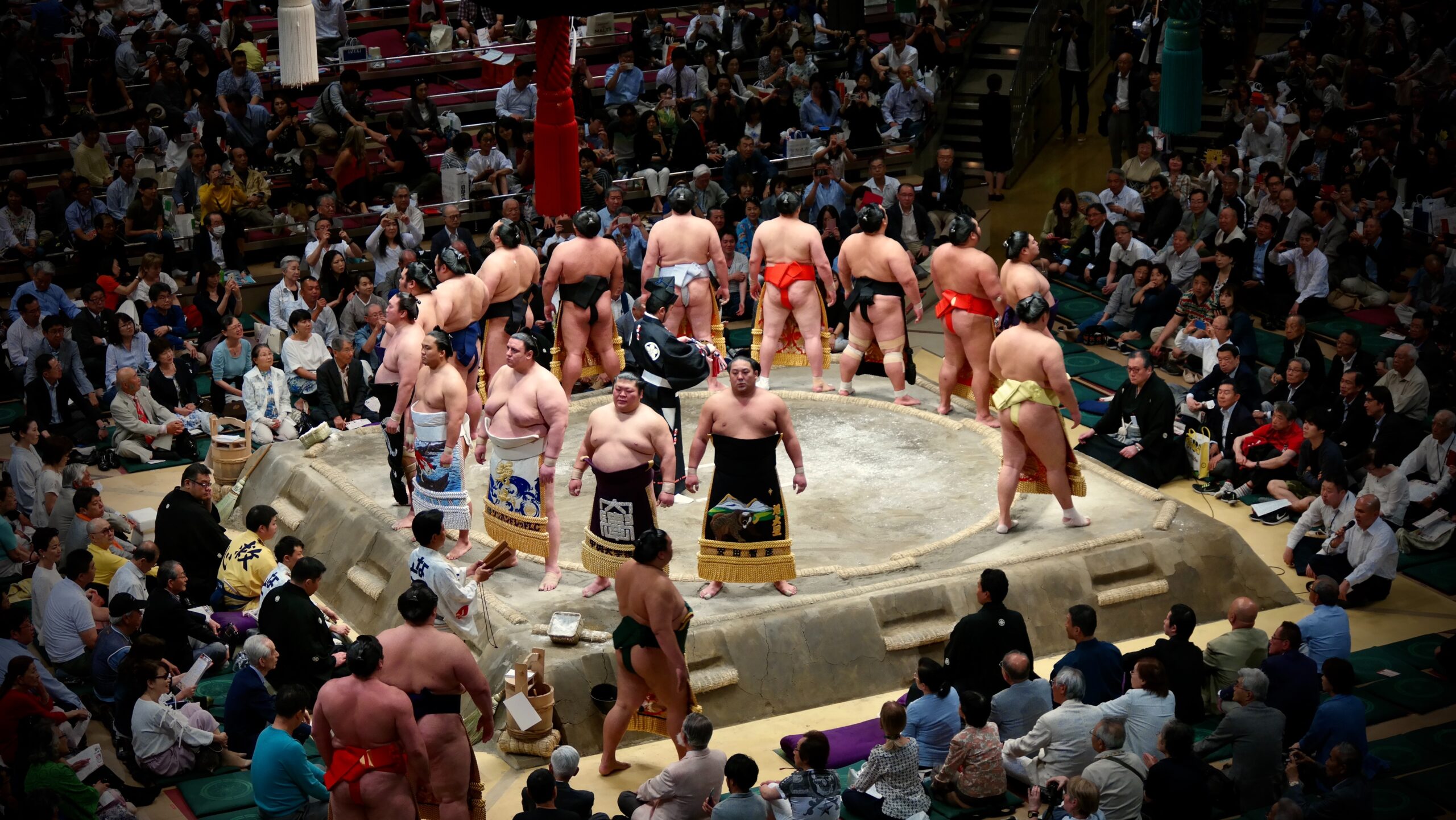Sumo is a style of full-contact competitive wrestling in which a rikishi (wrestler) attempts to throw or push his opponent out of a circular ring (dohyo) or force him to strike the ground with any part of his body other than his feet’s soles.
Sumo started in Japan, which is also the only place where it is done professionally and is considered the national sport. It is a modern Japanese martial art called gendai budo, but the sport has been around for many centuries. Sumo has kept alive a lot of old customs, and it still has many religious elements, like the use of salt to clean, that come from Shinto.
As a wrestler, you have to follow a lot of rules set by the Japan Sumo Association. Most sumo wrestlers have to live in heya, which is the Japanese word for a training stables where they all live together and follow strict rules about everything from what they eat to how they dress.
The History of Sumo
Sumo’s true roots have been lost to time, however the first sumo matches are claimed to have taken place during the Yayoi era. Sumo wrestling was once an element of Shinto ceremonies, in which wrestlers summoned or “fought” kami (spirits).
Sumo is even described in a 712 CE (Common Era) document called “kojiki” that talks about Japanese mythology. This text tells the story of how the god of thunder (Takemikazuchi) and the god of water (Takeminakata) wrestled to decide who owned the Japanese islands.
The Earliest Sumos
The Nihon Shoki, a book written in 720 CE, was the first time a sumo match between gods that wasn’t divine was described. It says that the first sumo match happened in 23 BCE (Before Common Era), when Emperor Suinin asked a guy named Nomi no Sukune to fight Taima no Kuehaya. This wrestling match was fought to the death, and Nomi no Sukune came out on top. From that point on, Nomi no Sukune was known as the father of all sumo.
Before the Middle Ages, there were no rules for sumo, and fights often ended in the death of one of the fighters. These fights became a popular way to have fun in the courts of Japanese emperors. In 642 CE, fights were held at the court of Empress Kogyoku to entertain a Korean guest.
The Middle Ages
As the Emperor’s central power in Japan declined in the 10th and 11th centuries, sumo’s prominence as a royal entertainment declined. Sumo was used to train samurai to fight in hand-to-hand combat during the Kamakura period (1180 CE – 1330 CE). There was far less emphasis on the spiritual and religious nature of sumo during this time period.
Sumo had become a popular event among all classes of people in Japan by the 1330s. Sumo wrestlers were frequently sponsored by wealthy landowners (daimyo). Sumos who successfully campaigned for a daimyo’s favor could get lavish gifts and even samurai title.
Oda Nobunaga, a powerful landowner and feudal lord, was an enthusiastic sumo lover. In 1578, he hosted a wrestling competition for 1500 wrestlers from all around Japan. The tournament winner was awarded a bow for his victory, and he allegedly began dancing to express his thanks to the warlord.
The Edo Period
Sumo basically became what it is today during the Edo era (1603–1867). Sumo matches were held to raise money to build shrines and temples or repair bridges. This is how professional sumo wrestlers came to be. A sport that was once only for the rich and powerful became popular with the masses. Sumo tournaments were frequently held in Edo (now Tokyo), Osaka, and Kyoto. The fame of the sport grew with the sale of color woodblock prints (nishiki-e) that showed sumo scenes and pictures of wrestlers. The government of the time, though, often gave orders to ban sumo because it led to constant fighting and arguing.
For this reason, the people who started sumo agreed on a set of rules, such as a list of 48 kimarite (winning techniques) and the round ring that is still used today. Wrestlers were trained in stables.
Sumo still has a lot of old Japan in it, like topknots, traditional clothing, and old customs. Because of this, professional sumo is more than just a sport; it’s a live example of traditional Japanese culture. As representatives of the sport, sumo wrestlers go on tours outside of Japan to share Japanese culture.
Japan Sumo Association
Sumo wrestling is a popular sport in Japan. The Japan Sumo Association is in charge of the sport. The Association, which has been around since 1925, is in charge of organizing, marketing, and keeping an eye on the professional sumo world. They make the rules for the sport, train and license all professional sumo wrestlers, and run tournaments and championships. The Japan Sumo Association is also in charge of giving former sumo wrestlers and their families financial and social help. The Japan Sumo Association is in charge of the professional sumo world, and it also sponsors shows, festivals, and other events to spread the word about sumo to the general public. The Japan Sumo Association wants to keep the sport going so that it can be enjoyed by people in the future.
Sumo Attire
During a match, the only thing the rikishi wears is a loincloth called a mawashi. It is made of heavy silk and is about 10 yards long and 2 feet wide. It is folded in half six times and then wrapped around the waist four to seven times, based on how big the rikishi is. The strings that hang from the front of the mawashi are made of silk and rigid glue, and they are purely decorative. During the course of a bout, it is not unusual for them to become detached. Rikishi only use one mawashi in events until it wears out, which could take several years.
Rikishi never wash the mawashi of their opponents. They just brush them off and hang them up in the sun because of two things. One reason is that they think that washing the mawashi would wash away the luck they have gained from their previous wins. And second, washing weakens the silk cloth, which could be a problem during a match because a mawashi that isn’t safe is a reason to be disqualified.
Sumo wrestlers keep their hair long and wear it in top-knot styles that were popular during the Edo Period. A rikishi’s rank is shown by the type of top-knot they wear. The top-level maku-uchi and juryo fighters wear a more elaborate style called o-ichi-mage, which looks like a gingko leaf. The lower classes wear chon-mage, a simple topknot with paper strings. Top-knots are still used in sumo not only to keep up with tradition, but also because they keep the head from hitting the ground if the wrestler falls.
The Sumo Ring (dohyo)
The dohyo, or ring, is probably the first thing you’ll notice when you walk into a sumo field. It might shock you how small it is. It is made of a special kind of clay and is 18 square feet and 2 feet tall. Straw bales are buried in the dirt, and a small piece of one of them sticks up to mark the play area. This means that fights can only happen inside an area about 15 feet across.
The clay is covered with a thin layer of sand, which is cleaned out between matches. Over the dohyo, wires hold up a roof that looks like a Shinto temple. In each corner, there are four bows, one for each season.
Rules of Sumo Wrestling
Basically, the first rikishi who touches the ground with any part of their body (including their top-knot) or is pushed outside the inner circle of the dohyo loses.
There are also rules against striking with fists, hair pulling, eye gouging, choking, kicking in the stomach or chest, and seizing the part of the loincloth (mawashi) that covers the vital organs.
There are no weight divisions or limits in sumo, so a rikishi may find themselves facing an opponent twice their size. However, weight is not always an indication of how a bout will play out. Smaller rikishi might use their opponent’s weight to their advantage, while a bigger sumo wrestler might find it harder to get back on their feet when they lose their balance and fall under their own weight.
Sumo Division
Depending on how well they do, wrestlers, or rikishi, are divided into 6 different division. They can be promoted to higher ranks if they do well in events, but they can also be demoted if they don’t. Which class a wrestler is ranked in is important because it shows his skill and also affects how much money he makes. Even within the divisions, there are more levels of classification. For example, yokozuna is the top rank in the makuuchi division.
1. Jonokuchi
Sumo wrestlers begin their careers in the lowest category, jonokuchi, after competing in at least one maezumo match. It’s mostly made up of young hopefuls who aren’t called professionals yet. Experienced wrestlers can fall from the top ranks, usually because they get sick or hurt and can’t compete for a long time, but they almost never get sent back to jonokuchi. It’s not hard to move up from jonokuchi, and many wrestlers are bumped up just to make room for the new trainees.
2. Jonidan
Wrestlers in the Jonidan rank now have some experience, but only the best get moved up. This, along with the fact that there is no limit on the number of wrestlers, makes this class the biggest of the six. Hazing will still happen to them, and there are some rules about what they can wear. Sumo wrestlers have to wear traditional Japanese clothes even when they’re not in the ring, and those in the jonidan ranks can’t wear haori (a kimono jacket) even when it’s cold.
3. Sandanme
Still, sandanme wrestlers are not thought to be professionals. Like jonokuchi and jonidan, wrestlers get a small allowance for doing chores at the stable after each competition. This comes out to about 2,000 USD for sandanme, plus bonus money for winning fights. In sandanme, there can be no more than 200 fighters.
4. Makushita
Makushita is the last step between being an unranked fighter who doesn’t get paid and becoming a sekitori, which is the highest rank. It’s normal for higher-ranked wrestlers to end up in makushita, which is a very bad thing. They have to go back to getting a small wage every two months and doing work around the training stable. Makushita and all the lower ranks only play 7 times per event. If you are a makushita wrestler and win all 7 of your matches, you will be automatically moved up to juryo, which is the next best rank.
5. Juryo
Wrestlers with a Juryo ranking are now thought to be professional competitors. Sekitori are the fighters in the juryo and makuuchi ranks. A professional ranked sekitori sumo wrestler makes an average of one million yen, or $8,800 USD, per month, in addition to other perks and award money. Juryo wrestlers fight 15 times per tournament, while wrestlers in the older ranks only had 7 matches.
6. Makuuchi
The goal of every professional sumo wrestler is to get to makuuchi. Here is where the san’yaku, or title holders, are ordered. The yokozuna is at the top, followed by the ozeki, sekiwake, and komusubi. These titles can be held by more than one wrestler at the same time, and there can only be 42 wrestlers in the makuuchi class. Makuuchi wrestlers get paid well and are usually the most well-known because their matches are shown on normal TV.
Life as a Professional Sumo Wrestler
A trained sumo wrestler has a very regimented way of life. The Sumo Association has rules for how its fighters should act. For example, the association says that wrestlers can’t drive cars. This is partly because many wrestlers are too big to fit behind a steering wheel. If a wrestler or his stablemaster breaks the rules, they can both be fined or even suspended.
When they join sumo, they are supposed to let their hair grow long enough to make a topknot, or chonmage, like the samurai hairstyles of the Edo period. Also, they are supposed to wear the chonmage and traditional Japanese clothes when they are out in public. This makes them easy to spot as wrestlers.
The type and quality of the dress rely on the wrestler’s rank. Rikishi in jonidan and lower are only allowed to wear a thin cotton robe called a yukata, even in winter. Also, when they go outside, they must wear shoes made of wood called geta. In the makushita and sandanme divisions, wrestlers can wear zori, which are traditional straw shoes, over their yukata. The higher-ranking sekitori can wear any silk dress they want, and the quality of the dresses has gotten much better. They are also expected to wear a more elaborate style of topknot called an oicho (big ginkgo leaf) on formal events.
There are similar differences in settled life. The younger wrestlers have to get up the earliest, around 5 am, for training, while the sekitori can start around 7 am. When the sekitori are training, the younger wrestlers may have to do things like help cook lunch, clean, and prepare baths, hold a sekitori’s towel, or wipe his sweat. The order of who bathes after training and who eats lunch is still based on the ranking system.
Conclusion
Sumo wrestling has a long, interesting past that is deeply rooted in Japanese culture. It started out as a way to fight in rituals, but now it is a very recognized sport. The mawashi and traditional hairstyle are the most famous parts of a sumo wrestler’s outfit. They show how dedicated they are to custom and discipline. The dohyo, which is the sumo ring, is a holy place where fierce fights take place. The Japan Sumo Association makes sure that the rules of sumo wrestling are fair and keep the sport’s reputation. The way the divisions are set up makes it clear how wrestlers can move up based on their skills and results. A sumo wrestler’s life is also centered around hard training, living together in training stables, and living a disciplined life. Sumo wrestling is a great example of how culture, physical strength, and deep-rooted customs continue to fascinate people all over the world.



